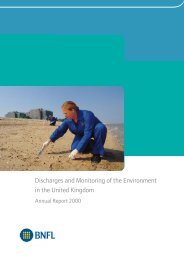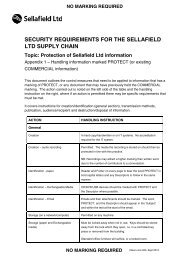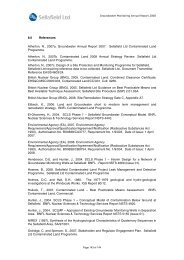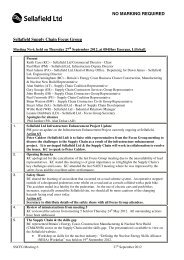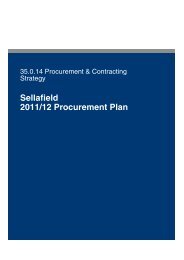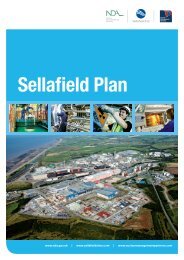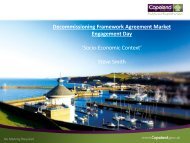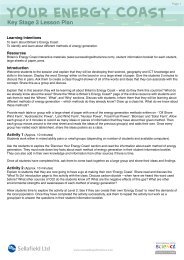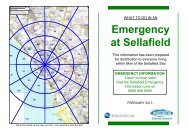Annual Report for 2010/11 and Forward Programme - Sellafield Ltd
Annual Report for 2010/11 and Forward Programme - Sellafield Ltd
Annual Report for 2010/11 and Forward Programme - Sellafield Ltd
Create successful ePaper yourself
Turn your PDF publications into a flip-book with our unique Google optimized e-Paper software.
SSEM/20<strong>11</strong>/4730 June 20<strong>11</strong>Recommendations12 Consideration to be given to maximise the use ofspatial methods of analysis <strong>and</strong> mapping.13 Evaluation of trends in finds is time series shouldbe carried out, but first the series need to beadjusted <strong>for</strong> monitoring ef<strong>for</strong>t (seerecommendations 3, 5, & <strong>11</strong>). Statistical modelsshould then be used to account <strong>for</strong> seasonality<strong>and</strong> <strong>for</strong> possible autocorrelations. In the firstinstance, regression type models would beappropriate, (such as ARIMA) models to explorechanges over the monitoring period.14 Multivariate statistical techniques includingcluster <strong>and</strong> discriminant analysis could be usedto explore these features further, <strong>and</strong> todistinguish possibly distinct populations of finds.SL initial responseTo be considered <strong>for</strong> inclusion into statisticswork programme.To be considered <strong>for</strong> inclusion into statisticswork programme.To be considered <strong>for</strong> inclusion into statisticswork programme.Table 3.18. Statistical sampling report recommendationsRecommendations1 Consideration should be given to whether thecurrent categorisation of particles also reflectsdifferences in other risk related properties, i.e.properties which may affect their longevity inthe environment <strong>and</strong> solubility within thehuman stomach.2 An assessment as to whether particles behavein a similar manner to the sediment withinwhich they are found. Simply, does the hostsediment have similar size <strong>and</strong> densitycharacteristics to particle.3 Full <strong>and</strong> quantified specification of objectiveswithregard to area, probability of detection <strong>for</strong>specific radionuclides <strong>and</strong> to an appropriatedepth to be agreed. The depth should reflecthabit in<strong>for</strong>mation <strong>and</strong> the temporal <strong>and</strong> spatialdynamic of the beach.4 Following an assessment of beach dynamics,particle abundances, beach users’ habits etc,the regulator <strong>and</strong> other agencies should specify(in consultation with other parties) a minimumbeach coverage, frequency <strong>and</strong> detectioncapabilities - depth <strong>and</strong> activity (which shouldbe reviewed regularly).SL initial responseIt is judged that the categorisation of finds ishelpful in assessing risk to the critical group. Forexample, significant ef<strong>for</strong>t that been expended inmeasuring the parameters of alpha-rich finds(i.e. the high risk group). Consideration is givento the relative risks of sub-groups as new databecomes available (e.g. Magnox vs Oxidesubgroups etc.).The variation in s<strong>and</strong> characteristics issignificant over the range of beaches monitored<strong>and</strong> within individual beaches. To overcome thisproblem consideration is being given to thecharacterisation of s<strong>and</strong> in a pocket around thefind. This would give in<strong>for</strong>mation on thesimilarities between the find <strong>and</strong> local s<strong>and</strong> <strong>and</strong>the variation in s<strong>and</strong> between different locations.The objectives are reviewed be<strong>for</strong>e setting eachyear's monitoring programme, taking account oftechnical issues <strong>and</strong> learning from experience.Explicit analysis <strong>and</strong> statistical objectives will beconsidered when developing future workprogrammes <strong>and</strong> will be incorporated into themonitoring programme review.The regulator <strong>and</strong> other stakeholders require SLto propose a monitoring programme thatincorporates the minimum beach coverage,frequency, <strong>and</strong> detection capabilities - depth <strong>and</strong>activity. Where possible this should be based ona statistical analysis but the statistical samplingreport recognises that there are limitations tothis approach. The 20<strong>11</strong>/12 repeat visits willallow further refinement to future monitoringprogrammes.© Nuclear Decommissioning Authority 20<strong>11</strong>. 62



